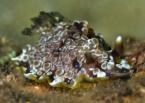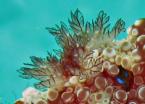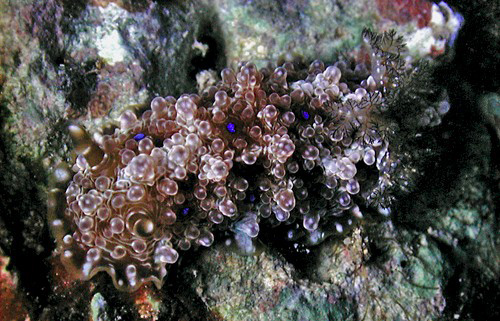| Home |
| Acknowledgments |
| Conventions |
| Glossary |
| Maps |
| References |
| Links |
| Articles |
| Thumbnails |
| Species
list |
| Family |
| Next
species |
Additional Photos

multiple spots

young, 3.5 mm

rhinophores

branchia
_______________
GALLERY

Dendrodoris krusensternii (Gray, 1850)

| Maximum size: about 38 mm. Identification: The notum of this species is covered with fleshy tubercles of varying sizes except in 3-4 paired areas on either side of the mid-line where it is smooth. The body is translucent brown with a variable amount of white spotting. Within each of the smooth areas is one large (or, sometimes, several small) iridescent blue spots. (Note 1) The rhinophores are gold to brown with white tips and brown stalks while the gills are translucent cream with dark brown edges. The tubercles become more elaborate in larger animals. Natural history: Dendrodoris krusensternii is a moderately rare species that has been found in protected to highly exposed rocky habitats from 1-110 m (3-361 ft). It lays a pale brown egg mass. Distribution: Big Island, Maui, Oahu, Kauai and Midway: widely distributed in the Indo-Pacific. Taxonomic notes: This species was first recorded in Hawaii off Hale'iwa, Oahu by Terry Gosliner in Nov., 1972 (dredged). It's listed in many sources as Dendrodoris denisoni (Angas, 1864). (Note 2) Photo: PF: 30 mm: Midway Atoll: June 7, 1993. Observations and comments: Note 1: The blue spots on a gold background aren't as precisely matched to the blue and gold ocelli found in the sea hares Stylocheilus striatus and Phycophila euchlora as are the markings in some other possible mimics. But, perhaps they are close enough so that D. krusensternii is still deriving some benefit from the resemblance (since the sea hares are known to concentrate toxins from the cyanobacteria they eat)? Note 2: There's some chance that animals with single blue spots in their lateral depressions and many light pustules on the tips of their tubercles might turn out to be different from animals with multiple blue spots in their lateral depressions and few light pustules on the tips of their tubercles. |
| Thumbnails |
Species
list |
Family | Next species | Top |